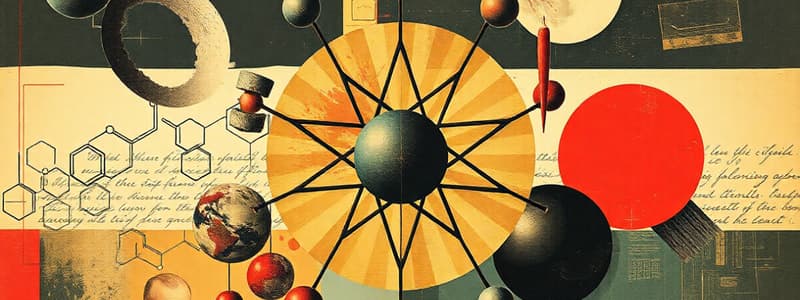Podcast
Questions and Answers
What does Avogadro's Law state about gases?
What does Avogadro's Law state about gases?
- Equal volumes of gases have different masses.
- Equal volumes of gases at the same temperature and pressure contain equal numbers of molecules. (correct)
- Gases behave differently at varying temperatures.
- The mass of a gas is directly proportional to its volume.
Which equation represents the Ideal Gas Law?
Which equation represents the Ideal Gas Law?
- PV = n^2RT
- PV = nRT (correct)
- PV = nRT^2
- PV = nR/T
Which of the following is NOT a common laboratory technique in chemistry?
Which of the following is NOT a common laboratory technique in chemistry?
- Volumetric analysis
- Titration
- Spectroscopic methods
- Mathematical modeling (correct)
What is a crucial aspect of laboratory practices?
What is a crucial aspect of laboratory practices?
Which study habit can enhance success in a chemistry course?
Which study habit can enhance success in a chemistry course?
What defines the atomic number of an atom?
What defines the atomic number of an atom?
Which type of bond involves the sharing of electrons between two nonmetals?
Which type of bond involves the sharing of electrons between two nonmetals?
What is the primary focus of stoichiometry in chemistry?
What is the primary focus of stoichiometry in chemistry?
Which of the following is an example of a chemical reaction type?
Which of the following is an example of a chemical reaction type?
What is unique about isotopes of an element?
What is unique about isotopes of an element?
What do balanced chemical equations represent?
What do balanced chemical equations represent?
Which property determines the polarity of a molecule?
Which property determines the polarity of a molecule?
What does the Law of Definite Proportions state?
What does the Law of Definite Proportions state?
Flashcards
Atom
Atom
The smallest unit of an element that retains the chemical properties of that element.
Protons
Protons
The positively charged particles found in the nucleus of an atom.
Neutrons
Neutrons
The neutral particles found in the nucleus of an atom.
Electrons
Electrons
Signup and view all the flashcards
Chemical Bond
Chemical Bond
Signup and view all the flashcards
Ionic Bond
Ionic Bond
Signup and view all the flashcards
Covalent Bond
Covalent Bond
Signup and view all the flashcards
Stoichiometry
Stoichiometry
Signup and view all the flashcards
Avogadro's Law
Avogadro's Law
Signup and view all the flashcards
Ideal Gas Law
Ideal Gas Law
Signup and view all the flashcards
Measurement Techniques
Measurement Techniques
Signup and view all the flashcards
Titration
Titration
Signup and view all the flashcards
Proper Lab Practices
Proper Lab Practices
Signup and view all the flashcards
Study Notes
Introduction to First Semester Chemistry (MJCC)
- First semester chemistry covers foundational general chemistry concepts.
- Topics include atomic structure, bonding, stoichiometry, and reaction types.
- Curriculum may vary by institution and instructor.
- Lab work complements theory, illustrating chemical principles through experiments.
Atomic Structure
- Atoms consist of protons, neutrons, and electrons.
- Protons and neutrons are within the nucleus; electrons orbit the nucleus.
- Atomic number is the number of protons in an atom.
- Mass number is the total of protons and neutrons.
- Isotopes are atoms of the same element with differing neutron counts.
- Electron configuration details electron arrangement in orbitals.
- The periodic table organizes elements by atomic structure and properties.
- Periodic table trends involve atomic radius, ionization energy, and electronegativity.
Bonding
- Chemical bonds hold atoms in molecules and compounds.
- Ionic bonds form between metals and nonmetals via electron transfer.
- Covalent bonds form between nonmetals by electron sharing.
- Metallic bonds feature delocalized electrons, typical of metals.
- Molecular polarity depends on electronegativity differences. Nonpolar molecules share electrons equally; polar molecules share unequally, creating a dipole.
Stoichiometry
- Stoichiometry examines quantitative relationships in reactions.
- Mole calculations use molar mass for mass-mole conversions.
- Chemical equations represent reactants and products with coefficients showing molar ratios.
- Mole ratios are essential for calculations like predicting yields and identifying limiting reagents.
Chemical Reactions
- Chemical equations show reactants turning into products.
- Balancing equations maintains mass conservation by adjusting coefficients.
- Reaction types include synthesis, decomposition, single displacement, double displacement, combustion, and neutralization.
Essential Concepts
- Law of Conservation of Mass: Mass is constant in chemical reactions.
- Law of Definite Proportions: Compounds maintain consistent element mass ratios.
- Avogadro's Law: Equal gas volumes at identical temperature and pressure contain equal molecules.
- Ideal Gas Law: PV = nRT (used for calculations).
Laboratory Techniques
- Chemistry labs use experimental techniques.
- Measurements involve mass, volume, and temperature.
- Techniques like titrations, volumetric analysis, and spectroscopy are used.
- Proper lab practices are critical for safety and accuracy.
Other Important Considerations:
- Applying concepts to real-world examples enhances understanding.
- Practice problems solidify concepts.
- Seek help from resources and ask questions.
- Effective time management and study habits improve course success.
Studying That Suits You
Use AI to generate personalized quizzes and flashcards to suit your learning preferences.




